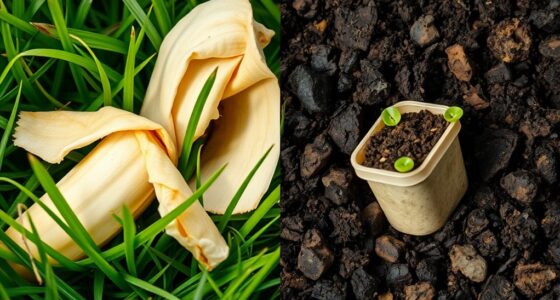Community gardens turn empty spaces into lively areas that boost neighborhood charm and bring people together. By growing fruits, vegetables, herbs, and flowers, you promote plant diversity and attract helpful insects while creating fresh food for your community. These gardens also foster social connections, encourage learning about sustainable practices, and strengthen collective pride. As you explore further, you’ll discover how these green spaces can truly transform your neighborhood and build lasting bonds.
Key Takeaways
- Transform vacant lots into vibrant green spaces that beautify neighborhoods and invite community engagement.
- Promote urban farming with diverse plants to support local food production and ecological resilience.
- Attract pollinators and beneficial insects, enhancing ecosystem health and reducing chemical use.
- Serve as social hubs where residents can connect, share skills, and foster community pride.
- Offer educational opportunities to learn sustainable gardening practices and environmental stewardship.

Have you ever wondered how communities come together to grow their own food and beautify their neighborhoods? Community gardens are a powerful way to do just that, transforming vacant lots and underused spaces into vibrant hubs of activity. When you participate in a community garden, you’re engaging in urban farming, a practice that brings fresh produce directly to local residents while fostering a sense of shared responsibility. Urban farming within these gardens often emphasizes plant diversity, which means you get to grow a variety of fruits, vegetables, herbs, and flowers. This diversity not only makes the garden more resilient to pests and diseases but also creates a more inviting and lively space for everyone involved.
As you tend to your plots, you’ll quickly realize that a diverse range of plants offers numerous benefits. Plant diversity attracts beneficial insects, supports pollinators like bees and butterflies, and enhances the overall health of the garden ecosystem. When you plant different crops together, you’re helping to create a balanced environment that reduces the need for chemical interventions. Plus, the variety of plants means there’s always something in season, giving you fresh ingredients to incorporate into your meals and encouraging healthy eating habits. This diversity also sparks curiosity and learning, as you discover how different plants grow, thrive, and interact. Incorporating plant diversity into urban gardening efforts can also contribute to healthier ecosystems by reducing reliance on chemical pesticides and fertilizers.
Participating in a community garden also means you’re contributing to the beautification of your neighborhood. The colorful blooms and lush greenery brighten up the surroundings, making the area more appealing for residents and visitors alike. Not only do these gardens provide a visual boost, but they also serve as gathering spots where neighbors can meet, share ideas, and build relationships. Working side by side, you’ll find that community gardens foster a sense of belonging and collective pride. The act of nurturing plants together helps break down social barriers and encourages collaboration, creating a stronger, more connected neighborhood.
Community gardens brighten neighborhoods and foster connections through shared growth and collaboration.
Another advantage of community gardens is the opportunity for education and skill-sharing. You can learn new gardening techniques, explore sustainable practices, and even teach others what you know. This ongoing exchange of knowledge strengthens the community’s capacity to maintain and expand the garden. Whether you’re a seasoned gardener or just starting out, your involvement helps to promote urban farming and plant diversity, making your neighborhood greener, healthier, and more resilient. Ultimately, community gardens are more than just places to grow food—they’re spaces that cultivate community spirit, environmental stewardship, and a shared sense of accomplishment.
Frequently Asked Questions
How Do Community Gardens Impact Local Property Values?
Community gardens can boost your property’s value by enhancing neighborhood development and attracting potential buyers. When your community invests in green spaces, it creates a more appealing environment, which often leads to increased property values. By supporting community gardens, you help foster a vibrant, attractive neighborhood that appeals to families and investors alike, ultimately making your area more desirable and contributing positively to local property markets.
What Are Common Challenges Faced by Community Garden Organizers?
You might feel like a gardener battling wild weeds when facing common challenges. Funding difficulties can drain your resources faster than a summer storm, making it hard to maintain the garden’s growth. Volunteer recruitment often feels like chasing butterflies—beautiful but elusive. These hurdles threaten to stifle your community’s blossoming potential, but with perseverance and outreach, you can cultivate a thriving, vibrant space that nurtures both plants and people alike.
How Can I Start a Community Garden in My Neighborhood?
You can start an urban farming community garden by first finding a suitable, accessible space and gaining permission from local authorities. Then, gather neighbors interested in gardening and plan the layout. Use composting techniques to create rich soil and promote sustainability. Organize regular meetings, assign roles, and seek funding or donations. With enthusiasm and teamwork, you’ll build a vibrant green space that fosters community connections and sustainable urban farming.
Are There Any Legal Restrictions for Community Gardens?
You might face legal restrictions like zoning regulations and liability concerns that could surprise you. Zoning laws often determine where community gardens can exist, while liability issues may arise if someone gets injured. Before starting, check with local authorities to understand restrictions and insurance requirements. Ensuring compliance helps you avoid legal pitfalls and protects your community efforts, making your garden both successful and sustainable.
What Are Sustainable Practices for Maintaining Community Gardens?
You can maintain your community garden sustainably by using composting techniques to recycle organic waste and enrich the soil naturally. Practice water conservation by installing drip irrigation systems and watering early in the morning or late evening to minimize evaporation. Mulching helps retain moisture and suppress weeds. Choose native plants that require less water and are adapted to your climate, ensuring a thriving, eco-friendly garden that benefits everyone.
Conclusion
As you nurture a community garden, you help cultivate more than just plants—you foster a sense of belonging and hope. These green spaces gently remind us that, even in busy lives, moments of growth and connection can bloom quietly, enriching our communities in ways words often can’t fully capture. By tending to these gardens, you’re planting seeds of kindness and unity that will flourish long after the last flower has faded.









